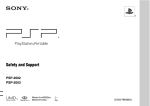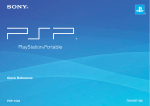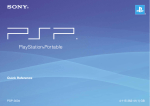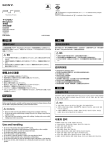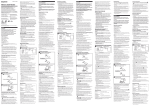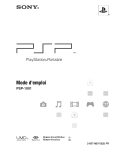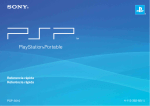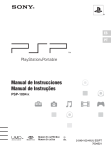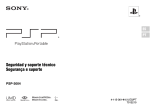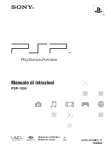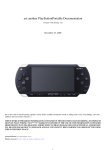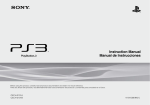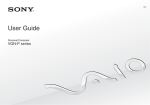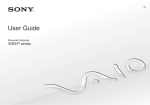Download 12508 PSP E-1000_GB_Web.indd
Transcript
GB Instruction Manual PSP-E1004 7017787 Table of contents Warning and caution WARNING······················································ 4 Support Troubleshooting ··········································· 28 Precautions ···················································· 6 Additional information Using the PSP® system Part names and functions ·····························10 the PSP® system ······································ 33 Charging the battery ·····································12 Specifications··············································· 34 Turning the system on and off·······················15 Compatible media ········································ 35 Using the XMBTM (XrossMediaBar) menu······16 Copyright and trademarks ··························· 37 Playing Universal Media Disc games············18 Playing Memory Stick DuoTM content·············19 Using the on-screen keyboard ····················· 20 Setting the parental control level·················· 22 Updating the system software ····················· 24 Downloading games ···································· 26 2 Before disposing of or transferring Table of contents PSP® system documentation You can find information about the PSP® system in this manual as well as online. • Instruction Manual (this document) This manual explains hardware features and provides basic information about how to set up and operate the PSP® system, including instructions on how to download and start playing games. The manual also includes warnings and precautions for the safe and proper use of the system. • User’s Guide This online guide contains detailed information about using PSP® system features. You can view the online user’s guide using a PC Web browser. eu.playstation.com/psp/support/manuals Information about system functionality and images published in this document may vary from those for your PSP® system, depending on the system software version in use. Table of contents 3 WARNING To avoid electrical shock, do not open the cabinet. Refer servicing to qualified personnel only. CAUTION - Use of controls or adjustments or performance of procedures other than those specified herein may result in hazardous radiation exposure. CLASS 1 LASER PRODUCT LASER KLASSE 1 PRODUKT This appliance is classified as a CLASS 1 LASER product under IEC60825-1+A2: 2001. This product is intended for ages 6 and up. Avoid prolonged use of the PSP® system. To help prevent eye strain, take a break of about 15 minutes during every hour of play. If you experience any of the following health problems, discontinue use of the system immediately. If symptoms persist, consult with your doctor. – Dizziness, nausea, fatigue or symptoms similar to motion sickness – Discomfort or pain in a part of the body, such as eyes, ears, hands or arms 4 WARNING Regulatory information The nameplate is located inside the disc cover of the system. The manufacturer of this product is Sony Computer Entertainment Inc., 1-7-1 Konan, Minato-ku, Tokyo 108-0075 Japan. The Authorised Representative for EMC and product safety is Sony Deutschland GmbH, Hedelfinger Strasse 61, 70327 Stuttgart, Germany. Distributed in Europe by Sony Computer Entertainment Europe Ltd, 10 Great Marlborough Street, London, W1F 7LP. About national export control Always play in a well lit environment. Take regular breaks, 15 minutes every hour. Avoid playing when tired or suffering from lack of sleep. Some individuals are sensitive to flashing or flickering lights or geometric shapes and patterns, may have an undetected epileptic condition and may experience epileptic seizures when watching television or playing videogames. Consult your doctor before playing videogames if you have an epileptic condition and immediately should you experience any of the following symptoms whilst playing: dizziness, altered vision, muscle twitching, other involuntary movement, loss of awareness, confusion and/or convulsions. This product may fall within the scope of national export control legislation. You must comply fully with the requirements of such legislation and of all other applicable laws of any jurisdiction in relation to this product. Repetitive Motion Injuries GB Warning and caution Photosensitivity Avoid prolonged use of the PSP® system. Take a 15 minute break every hour. Stop using the PSP® system immediately if you experience an unpleasant sensation or pain in your hands, wrists or arms. If the condition persists, consult a doctor. Headphones Adjust your headphone volume so that surrounding sounds can be heard. If you experience ringing or any discomfort in your ears, discontinue use of your Headphones. System Software The System Software included within this product is subject to a limited licence from Sony Computer Entertainment Inc. Refer to http://www.scei.co.jp/psp-eula/ for further details. WARNING 5 Precautions Before using this product, carefully read this manual and retain it for future reference. Accessory compatibility Do not use accessories or peripherals that are intended for another model of the PSP® system, as these accessories/ peripherals may not be compatible with your system. Visit http://eu.playstation.com/psp for details. Safety This product has been designed with the highest concern for safety. However, any electrical device, if used improperly, has the potential for causing fire, electrical shock or personal injury. To help ensure accident-free operation, follow these guidelines: Observe all warnings, precautions and instructions. Regularly inspect the AC adaptor. Stop use, unplug the AC adaptor from the electrical outlet and disconnect any other cables immediately if the device functions in an abnormal manner, produces unusual sounds or smells or becomes too hot to touch, or has become misshapen. 6 Precautions Use and handling Use in a well-lit area and keep the screen a safe distance from your face. Keep the system and accessories out of the reach of small children. Small children may swallow the Memory Stick Duo™ media or wrap the cables/straps around themselves, which may inflict injury or cause an accident or a malfunction. Do not use the system while driving or riding a bicycle. Do not use the system or accessories near water. Use only attachments/accessories specified by the manufacturer. Do not expose the system or accessories to high temperatures, high humidity, or direct sunlight. Do not leave the system or accessories in a car with the windows closed (particularly in summer). Do not expose the system or accessories to dust, smoke or steam. Do not allow liquid or small particles to get into the system or accessories. Do not place the system or accessories on surfaces that are tilted, unstable or subject to vibration. Do not throw, drop or step on the system or accessories, and do not subject the devices to strong physical shock. Sitting down with the PSP® system in a pocket or placing the system in the bottom of a backpack along with heavy objects may cause damage to the system. AC adaptor use For your safety, use only a supplied AC adaptor. Other types may cause fire, electrical shocks or a malfunction. Do not touch the plug of the AC adaptor with wet hands. Do not touch the AC adaptor or the system, if connected to an electrical outlet, during an electrical storm. Do not allow dust or foreign matter to build up around the system or accessory connectors. If there is dust or foreign matter on the system’s connectors or the AC adaptor, wipe it off with a dry cloth before connecting. Dust or other matter on the connectors can result in fire or electrical shock. Unplug the AC adaptor from the electrical outlet and disconnect any other cables from the system before cleaning or when you do not intend to use the system for an extended period of time. Protect the AC adaptor from being walked on or pinched particularly at plugs, convenience receptacles and the point where they exit from the system. When disconnecting the AC adaptor, hold it by the plug and pull straight out from the electrical outlet. Never pull by the cord and do not pull at an angle. Do not use the system to play games or video when the system is covered with any type of fabric. If you want to pause or temporarily store the system while playing games or video, put the system in sleep mode before placing it in the case or covering. Also do not use the AC adaptor when covered with fabric to help avoid overheating. Do not connect the AC adaptor to a voltage transformer or inverter. Connecting the AC adaptor to a voltage transformer for overseas travel or an inverter for use in an automobile may cause heat to build up in the AC adaptor and may cause burns or a malfunction. Precautions GB Warning and caution Do not forcibly twist the PSP® system or expose the system to strong physical shock during gameplay, as doing so can damage the system. Handle the analog stick with care. Do not put heavy objects on the system or accessories. Do not touch or insert foreign objects into the connectors of the system or accessories. Depending on the conditions of use, the system or AC adaptor may reach temperatures of 40°C or more. Do not touch the system or AC adaptor for an extended period of time under these conditions. Extended contact under these conditions may cause low-temperature burns*. * Low-temperature burns are burns that occur when the skin is in contact with objects of relatively low temperatures (40°C or more) for an extended period of time. 7 8 LCD screen About the “pickup” The LCD screen is made of glass and may crack if subjected to excessive force. Pixels that are not lit or are continuously lit may appear in certain locations on the LCD screen. The appearance of such spots is a normal occurrence associated with LCD screens and is not a sign of a system malfunction. LCD screens are made using highly precise technology. However, a very small number of dark pixels or continuously lit pixels exist on each screen. Also, a distorted image may remain on the screen for several seconds after the system has been turned off. Direct exposure to sunlight may damage the system’s LCD screen. Be careful when using the system outdoors or near a window. When using the system in a cold environment, you may notice shadows on the graphics or the screen may appear darker than usual. This is not a malfunction, and the screen will return to normal when the temperature goes up. Do not leave still images displayed on the screen for an extended period of time, as doing so may cause a faint image to be left permanently on the screen. Do not touch the “pickup” located inside the disc cover of the system. Touching the pickup may damage the system. Precautions Pickup Never disassemble the system or accessories Use the PSP® system and accessories according to the instructions in this manual. No authorisation for the analysis or modification of the system, or the analysis and use of its circuit configurations, is provided. Disassembling will void the system warranty and may be harmful. The LCD screen, in particular, contains dangerous, high-voltage parts, and the laser beam for reading Universal Media Disc may cause visual impairment if exposed directly to the eyes. Moisture condensation Do not use a chemically-treated cleaning cloth to wipe off the system. Before using the analog stick Do not attempt to remove the analog stick from the system front, as doing so will damage the system and may result in injury. (Settings) (System Settings), For best results, go to and then with the [System Information] screen displayed, rotate the analog stick in a circular motion to adjust the analog stick’s range of movement. Universal Media Disc handling Cleaning Do not touch the opening on the rear of the disc (recorded surface of the disc) with your fingers. Do not allow dust, sand, foreign objects or other types of dirt to get on the disc. If the Universal Media Disc becomes dirty, gently wipe the exterior and recorded surfaces of the Universal Media Disc using a soft cloth. Do not use solvents or other chemicals. Do not use a Universal Media Disc that is cracked or warped or has been repaired. The Universal Media Disc may break inside the PSP® system, leading to injury or malfunction. For safety reasons, unplug the AC adaptor from the electrical outlet and disconnect any other cables before cleaning the system. Handling and care of exterior surfaces Follow the guidelines listed below to help avoid deterioration or discolouration of the PSP® system. Do not use solvents or other chemicals to clean the exterior surface. Do not allow the system to remain in direct contact with rubber or vinyl products for an extended period of time. Cleaning the exterior surface and LCD screen Wipe gently with a soft cloth. Cleaning the connectors GB Warning and caution If the PSP® system or Universal Media Disc is brought directly from a cold location to a warm one, moisture may condense on the lens inside the system or on the Universal Media Disc. Should this occur, the system may not operate properly. In this case, remove the Universal Media Disc and turn off and unplug the system. Do not put the Universal Media Disc back in until the moisture evaporates (this may take several hours). If the system still does not operate properly, contact the appropriate PSP® customer service helpline which can be found within every PSP® format software manual. If the connectors on the PSP® system or on the USB cable become dirty, signals may not be sent or received properly. Also, if the connector on the headphones becomes dirty, you may experience noise or interruptions in sound. Wipe the connectors with a dry, soft cloth to keep in clean condition. Cases and coverings When placing the PSP® system in a commercially available case, turn off the power or put the system in sleep mode. Do not use the system while it is in the case. Leaving the system on, or using it while in a case or covering may cause overheating or may damage the system. Precautions 9 Part names and functions 3 4 5 6 7 8 9 2 1 10 System bottom 11 12 13 14 15 16 10 Part names and functions 17 18 1 2 3 5 POWER indicator 15 START button Speaker Solid green Power on 16 Strap holder L button Solid orange Charging ™ Memory Stick PRO Duo slot Flashing green Charge level low ™ Memory Stick PRO Duo access indicator Lights up when data is being read or written from Memory Stick DuoTM media. Notice When the Memory Stick PRO Duo™ access indicator is lit, do not eject the Memory Stick Duo™ media, turn off the system, or put the system into sleep mode, as doing so may cause data loss or corruption. Attach a strap (sold separately) as shown below. Light off Power off/In sleep mode 7 USB connector 8 LCD screen 9 R button 10 button, button, 11 Analog stick 17 POWER/HOLD switch Slide right Turn the system on and off ( page 15). button, button Slide left Lock the system buttons. GB Using the PSP® system 4 6 Directional buttons 18 Headset connector For use with games that support analog stick operation 12 PS button 13 Volume button 14 Select button Part names and functions 11 Charging the battery Before using the PSP® system for the first time after purchase, or when the battery charge level is low, follow the steps below to charge the battery. Charging methods Charging with an AC adaptor The system’s battery can be charged using an AC adaptor. Caution Stop use, unplug the AC adaptor from the electrical outlet and disconnect any other cables immediately if the device functions in an abnormal manner, produces unusual sounds or smells or becomes too hot to touch, or has become misshapen. POWER indicator Do not plug the AC adaptor for the PSP® system into an electrical outlet until you have made all other connections. The socket-outlet shall be installed near the equipment and shall be easily accessible. 1 2 To electrical outlet The power indicator lights up in orange, indicating that charging has begun. The power indicator turns off when the battery is fully charged. 12 Charging the battery Charging with a USB device Information about the battery charge Checking the battery charge level You can check the battery charge level by the icon displayed in the upper right corner of the screen. Hints You cannot charge the PSP® system using a USB device while playing a game or performing other operations. Use the AC adaptor to charge the battery in such situations. (Settings) To switch to USB mode manually, select (USB Connection). Charging may take longer when the system is turned on during charging or when a USB device is used for charging. You may not be able to charge the battery if the USB device or the USB hub does not provide enough power for charging. Try connecting to a different USB device or a different USB connector on the device. GB Using the PSP® system When you turn on the PSP® system and then connect it to a device equipped with a USB connector (such as a PC), the system’s battery will begin charging. While the battery is charging, the POWER indicator will be lit in orange and [USB Mode] will be displayed on the screen. When there is little battery charge left, the icon is displayed and the power indicator flashes green. If this happens, charge the battery. Hints Depending on usage conditions and environmental factors, the charge level may not reflect the exact charge level. Charging the battery 13 Estimating the battery charge time* Charging with the AC adaptor Approximately 2 hours 20 minutes Charging with a USB device Approximately 4 hours * When charging a battery with no charge remaining Hint Estimated battery duration Gameplay Approximately 3 - 5 hours*1 Video playback Approximately 3 - 4 hours*2 *1 Based on tests conducted with the system in single player mode, with headphones in use. *2 Based on tests conducted using variables of system speakers versus headphones, volume level and screen brightness level. Hint Battery duration may vary depending on the type of content being played, conditions of use and environmental factors. Battery duration will decrease with repeated usage and age. Charging the battery The built-in battery has a limited life span. Battery duration will decrease with repeated usage and age. When battery duration becomes noticeably short, contact the appropriate PSP® customer service helpline. Details are found within the contact information section at http://eu.playstation.com/support. Hint It is recommended that you charge the battery in an environment with a temperature of 10°C to 30°C. Charging in other environments may not be as effective and may lead to less than optimal battery performance. 14 Battery life Battery life span varies depending on how the battery is stored and the conditions of use, including long-term environmental factors such as temperature. Turning the system on and off Turning the system on POWER indicator 1 Slide the POWER/HOLD switch to the right. The POWER indicator turns off and the system enters sleep mode. Clearing sleep mode Slide the POWER/HOLD switch to the right. Hint GB Using the PSP® system 1 Slide the POWER/HOLD switch to the right. Putting the system in sleep mode You can pause the system while playing games or other content. Playback begins from the point where the system entered sleep mode. Some software may prevent the system from entering sleep mode. POWER/HOLD switch The POWER indicator lights up in green. Turning the system off 1 Slide and hold the POWER/HOLD switch to the right. for more than three seconds. The POWER indicator turns off. Turning the system on and off 15 Using the XMB™ (XrossMediaBar) menu The PSP® system includes a user interface called XMB™ (XrossMediaBar). 1 Select a category using the left or right button. 2 Select an item using the Category up or down button. 3 Press the Item button to confirm a selected item. Hint You can cancel an operation by button. pressing the Directional buttons Icons displayed on the screen vary depending on the system software version. 16 Using the XMBTM (XrossMediaBar) menu button button button Categories Using the options menu Select an icon, and then press the options menu. button to display the Game Play games Watch video Music Listen to music Photo Icons Options menu Using the control panel While playing content, press the control panel. View photos Extra button to display the Using the PSP® system Video GB View comics Settings Adjust PSP® system settings Control panel Using the XMBTM (XrossMediaBar) menu 17 Playing Universal Media Disc games 1 Place your finger in the indentation on the top of the system to open the disc cover. 3 Select the icon, and then press the 2 Insert a Universal Media Disc and close the disc cover. Check that the disc cover is tightly closed. Do not touch the recorded surface. Hints To remove the Universal Media Disc, stop playback and then open the disc cover. To save game data, you must first insert a Memory Stick Duo™ in the memory stick slot. Quitting a game Press the PS button to quit a game. 2 1 18 Playing Universal Media disc games button. Playback begins. PS button Playing Memory Stick Duo™ content 2 Select the icon, and then press the Warning button. 1 Press the Memory Stick Duo ™ media until fully inserted. Front side A list of content that can be played is displayed. Hint To remove the Memory Stick Duo™ media, press the media once in the direction of the arrow. GB Using the PSP® system Keep Memory Stick Duo™ media out of the reach of small children, as the media could be swallowed by accident. Notice When the Memory Stick PRO Duo™ access indicator ( page 11) is lit, do not eject the Memory Stick Duo™ media, turn off the system, or put the system into sleep mode. Doing so may cause data loss or corruption. Playing Memory Stick DuoTM content 19 Using the on-screen keyboard List of keys Cursor Operation keys Text entry field (display characters as they are entered) Keys that are displayed vary depending on the input mode in use and other conditions. Keys Explanation Inserts a space Confirms characters that have been typed but not entered, and then closes the keyboard Cancels characters that have been typed but not entered, and then closes the keyboard Moves the cursor Deletes the character to the left of the cursor Alphabet/symbol keys Input mode display Text entry options Displays a diagram showing the system buttons and their usage Switches between uppercase and lowercase letters Inserts a line break 20 Using the on-screen keyboard Switching the input mode Input mode Examples of characters you can enter Letters and numbers abcde Letters and numbers (with accented letters) éíóçñ Numbers only 12345 Web address shortcuts .com .ne .html .gif Hint The language for the on-screen keyboard is linked to the system language. You can set the system language by going to (Settings) (System Settings) [System Language]. For example, if [System Language] is set to [Français], you can enter text in French. The following steps explain how to enter text using the word “FUN” as an example. 1 Select [DEF3], and then press the button several times until “F” is displayed. Each time you press the button, the character that is entered in the text entry field is switched. 2 Select [TUV8], and then press the button several times until “U” is displayed. 3 Select [MNO6], and then press the button Using the PSP® system Input mode display GB Entering characters The number of input modes available varies depending on the language selected. Each time you press the SELECT button, the input mode changes to the options shown in the table below. several times until “N” is displayed. 4 Select [Enter], and then press the button. The characters you entered are confirmed. (You can also press the PSP® system’s R button to confirm a character.) Select [Enter] again, and then press the button to exit the keyboard. Hint If you select the a/A key while entering characters, you can switch between uppercase and lowercase letters. Using the on-screen keyboard 21 Setting the parental control level The PSP® system includes a parental control feature. You can use this feature to set a password and limit the playback of content (games, videos and other content) based on the parental control level on the system. By setting the parental control level, you can prevent the playback of restricted content by children. 1 Select A 4-digit password is required to allow playback of the restricted content and to change the parental control level. The default password is “0000” and can be reset. 2 Using the directional buttons, enter the To reset the password 1 Select (Settings) (Security Settings) [Change Password], and then press the button. Follow the on-screen instructions to set the password. 22 Setting the parental control level To set the parental control level (Settings) (Security Settings) [Parental Control Level], and then press the button. The password entry screen is displayed. 4- digit password, and then press the button. 3 Select a parental control level for the PSP® system ( page 23), and then press the button. The parental control level is set. Parental control levels on the PSP® system The playback of content is restricted using a combination of the parental control levels of both the PSP® system and the content. The parental control level on the system can be turned off or set to one of 11 levels. The default setting is [9]. Restriction Parental control levels on content Highest Off Parental control is turned off. 11-1 Set the restriction level on the system. A setting of [1] is the most restrictive; [11] is the least restrictive. 11 10 Content cannot be viewed 9 8 Hints 7 6 5 Content can be viewed 4 3 You can check the parental control level under [Information] in the options menu. Content that has been restricted by the parental control feature is displayed as (Restricted Content). 2 GB Using the PSP® system Information about parental control levels 1 1 2 3 4 5 6 7 8 9 10 11 Parental control levels on the PSP® system Restriction Highest For example, if you want to restrict playback of content that is set with parental control level “5”, adjust the parental control level on the PSP® system to [4]. Setting the parental control level 23 Updating the system software Software updates may include security patches, new or revised settings and features, and other items, which will change your current operating system. It is recommended that you always maintain your system to use the latest version of the system software. Obtain update data. Use the update data to overwrite the existing system software. Hints For the latest information on updates, visit eu.playstation.com/psp Depending on the software title, you may not be able to play without first updating the PSP® system software. After you have updated the system software, you cannot go back to an earlier version. Before starting, check that the battery is charged. You may not be able to start an update if the battery charge level is low. Checking the system software version The system software is updated. Notice During an update: • Do not remove the Universal Media Disc. • Do not turn off the system. • Do not disconnect the AC Adaptor. If an update is cancelled before completion, the system software may become damaged, and the system may require servicing or exchange. 24 Updating the system software You can check system software version information by selecting (Settings) (System Settings) “System Information”. The current version is displayed in the “System Software” field. Update methods You can perform an update in any of the following ways. Update using a Universal Media Disc Update using a PC Update using a PC to download update data from the Internet. For detailed instructions, visit eu.playstation.com/psp GB Using the PSP® system You can update using a Universal Media Disc that contains update data. 1 Connect the AC Adaptor to the PSP® system. 2 Insert a Universal Media Disc that contains update data. The update data icon and version number are displayed under (Game) in the Home Menu. 3 Select (PSPTM Update), and then press the button. The update begins. Follow the on-screen instructions to complete the update. Updating the system software 25 Downloading games Using Media Go, you can download (purchase) games from PlayStation®Store. To use PlayStation®Store, you need to connect your PC to the Internet. Media Go download mediago.sony.com/ What is Media Go? Media Go is a PC application that you can use to do the following: • Download (purchase) games from PlayStation®Store • Import tracks from an audio CD • Manage music, photo and video files PSP® system) • Transfer content (Media Go • Back up game data and saved data 26 Downloading games To access PlayStation®Store Click [Store] in the library navigation pane located on the left side of the Media Go window on your PC. Steps to download games PlayStation®Store User’s Guide manuals.playstation.net/document/storeindex.html Hints Create a PlayStation®Network account (sign up) ™ To download games, you must first insert a Memory Stick Duo into the Memory Stick PRO Duo™ slot of the PSP® system, then connect it to your PC using a USB cable. You can also download (purchase) games from PlayStation®Store via the PS3® system. Sign in GB Using the PSP® system To download games from PlayStation®Store, you must perform the following steps. For details, refer to the online user’s guide. Add funds to your online wallet Download a game Downloading games 27 Troubleshooting Go through this section if you experience difficulty in operating the PSP® system. Should any problem persist, please visit our Help and Support pages at http://eu. playstation.com/support. Power, battery and charging issues The PSP® system does not turn on. The battery charge may have run out. Charge the battery. The battery does not charge, or does not fully recharge. When using the AC adaptor to charge the battery, check the following: – The AC adaptor is fully inserted into the electrical outlet. – The correct AC adaptor for this product is being used. When using a USB device connected to the system to charge the battery, check or make note of the following: – The USB cable is fully inserted into the system and the USB device. – The USB device is turned on. 28 Troubleshooting – The system is set to USB mode. If [USB Mode] is not displayed on the screen, select (Settings) (USB Connection). – Some USB devices cannot be used to charge the battery. For details, see “Charging methods” ( page 12). – During gameplay and other operations, the battery cannot be charged using a USB device. The battery may not charge efficiently or charging may take longer depending on the usage conditions and environmental factors. For details, see “Information about the battery charge” ( page 13). Check that the AC adaptor and USB cable connectors are clean. If the connectors are dirty, wipe them with a soft, dry cloth. The battery charge doesn’t last long. The charge may run out sooner depending on the storage method, usage conditions or environment factors. For details, see “Information about the battery charge” ( page 13). The PSP® system is misshapen. The battery inside the PSP® system may bulge as the battery ages. Contact the appropriate PSP® customer service helpline. Details are found within the contact information section at http://eu.playstation.com/ support. Picture The screen suddenly turns dark. If Pixels that are not lit or are continuously lit on the screen do not disappear. LCD screens are made with highly precise technology, but in some cases, pixels that are not lit or are continuously lit may appear on the screen. This is not a system malfunction. For details, see “Precautions” ( page 6). The colour of the screen does not look right. The background colour may be set to change automatically at the beginning of each month. You (Theme Settings). can adjust this setting under There is no sound. Check that the volume on the system is not set to zero. Try raising the volume by pressing the volume + button on the top of the system. When headphones are connected, no sound is output from the PSP® system speakers. The volume does not turn up. GB Support (Power Save Settings) [Backlight Auto-Off] has been set, the LCD screen’s backlight will automatically turn off if the system is left inactive for the set amount of time. (Power Save Settings) [Auto Sleep] has been If set, the system will automatically enter sleep mode if left inactive for the set amount of time. Sound If (Sound Settings) [AVLS] is set to [On], the maximum volume level is restricted. The ear friendly Headphones are specifically designed to limit sound pressure level to a maximum of 90dB. The headphones do not emit sound or the sound contains noise. Check that the headphones are fully inserted. Universal Media Disc The system does not recognise the Universal Media Disc. Slide the POWER/HOLD switch right and hold it for at least three seconds until the POWER indicator turns off. Power will be completely cut off. After that, turn the system back on. Troubleshooting 29 Memory Stick Duo™ The Memory Stick Duo™ cannot be inserted. Set the Memory Stick Duo™ in the proper direction when inserting. Check that media of a type that can be used with the PSP® system is inserted. For details, see “Compatible media” ( page 35). The system does not recognise the Memory Stick Duo™. If Memory Stick Duo™ media is formatted using a PC, it may not be recognised by the PSP® system. If this happens, copy any data you want to keep on (System Settings) “Format the PC, and then go to Memory Stick™” and re-format. Check that the Memory Stick Duo™ is properly inserted. Try taking out the Memory Stick Duo™ and reinserting it. The system can’t save or load data. There may be a problem with the Memory Stick Duo™. Try using another Memory Stick Duo™, if available. The system does not recognise a video file. Video data of types that are not compatible with the PSP® system will not be recognised. If the file name or folder name is changed, or if the file or folder is moved to another location using a PC, the system may not recognise it. Music Music does not play. The playback methods may be limited for some music data that is distributed through the Internet. In such cases, the data may not be able to be played on the PSP® system. The system does not recognise a music file. Check that the music data is saved in the correct folder. For details, refer to the online user’s guide ( page 3). Music data of types that are not compatible with the PSP® system will not be recognised. Photo Video Videos do not play. Some types of data may not be able to be played. Images do not display. Depending on the image data size, certain images may not be viewable. If images are edited using a PC, they may not be viewable. 30 Troubleshooting The system does not recognise an image file. Check that the data is saved in the correct folder. For details, refer to the online user’s guide ( page 3). If the file name or folder name is changed, the system Other issues The system or AC adaptor is warm. During use, the system or AC adaptor may become warm. This is not a malfunction. The system is turned on, but does not operate. Check that the system is not in hold mode. If it is, slide the POWER/HOLD switch to clear hold mode. The system does not function properly. Slide the POWER/HOLD switch to the right and hold it for at least three seconds until the POWER indicator turns off. After the system is completely turned off, turn it on again. If the PSP® system is brought directly from a cold location to a warm one, moisture may condense inside the system. Should this occur, the system may not operate properly. Turn off and unplug the system, and then leave it unused for several hours. If the system still does not operate properly, contact the The date and time are reset. If the system is left unused after the battery charge runs out, the system date and time settings may be reset. Follow the on-screen instructions to set the time and date. The PSP® system is not recognised by the PC when connected using a USB cable. GB Support may not recognise it. Images that are not compatible with the PSP® system will not be recognised. appropriate PSP® customer service helpline. Details are found within the contact information section at http://eu.playstation.com/support. Check that your PSP® system is set to USB mode. If (Settings) (USB it is not, select Connection). Check that an operating system that supports USB mass storage class is installed in your PC in use. When using a USB hub or other devices, depending on the operating environment of the PC, the system may not be recognised by the PC. Try connecting the system directly to the PC using a USB cable. (System Settings) [USB Charge] is set to If [On], the device may not be recognised. The connected USB device is not recognised by the PSP® system. Check that the USB connector is clean. Try wiping it with a soft, dry cloth. You forgot your password. If you restore default settings under (System Troubleshooting 31 Settings) [Restore Default Settings], the system password will be reset to “0000”. For details, refer to the online user’s guide ( page 3). Note that if you restore default settings, settings you have adjusted for options other than the system password will also be cleared. Once cleared, these custom settings cannot be restored by the system. The analog stick does not function properly. At a scene where the symptoms appear, move the analog stick in a circular motion to help you determine the optimum operating range. 32 Troubleshooting Before disposing of or transferring the PSP® system 1 Select (Settings) (System Settings) [Restore Default Settings] to go back to the settings at the time of purchase. 2 Select (Settings) (System Settings) [Format System Storage] to delete all the data saved in the system storage. GB Where you see either symbol on any of our electrical products, batteries or packaging, it indicates that the relevant electrical product or battery should not be disposed of as general household waste in Europe. To ensure the correct waste treatment of the product and battery, please dispose of them in accordance with any applicable local laws or requirements for disposal of electrical equipment/batteries. In so doing, you will help to conserve natural resources and improve standards of environmental protection in treatment and disposal of electrical waste. This symbol may be used on batteries in combination with additional chemical symbols. The chemical symbols for mercury (Hg) or lead (Pb) will appear if the battery contains more than 0.0005% mercury or more than 0.004% lead. Additional Information Before disposing of or giving your PSP® system to another person for any reason, delete all the data and restore the default settings on the system. This will help prevent unauthorised access to or use of your credit card or other personal information. This product contains a battery which is permanently built-in for safety, performance or data integrity reasons. The battery should not need to be replaced during the lifetime of the product and should only be removed by skilled service personnel. To ensure the correct waste treatment of the battery, please dispose of this product as electrical waste. Before disposing of or transferring the PSP® system 33 Specifications Design and specifications are subject to change without notice. Operating environment temperature PSP® (PlayStation®Portable) system LCD screen 4.3 inches / 10.9 cm (16:9) fulltransparent type, TFT drive Approximately 16,770,000 colours displayed Sound Monaural speaker Internal disc drive Read-only Universal Media Disc drive Interface DC IN 5V connector Hi-Speed USB (USB 2.0 compliant) DC OUT connector Headset connector Memory Stick PRO Duo™ slot Power source 34 AC Adaptor: DC 5.0 V Rechargeable Battery Pack: Lithium-Ion rechargeable Battery Pack Maximum power consumption Approx. 6 W (when charging) External dimensions Approx. 172.4 × 73.4 × 21.6 mm (width × height × depth) (excludes largest projection) Weight Approx. 223 g (including Battery Pack) Specifications Compatible codecs 5°C – 35°C Universal Media Disc Video: H.264/MPEG-4 AVC Main Profile Level 3 Music: H.264/MPEG-4 AVC Main Profile Level 3, Linear PCM, ATRAC3plus™ Memory Stick™ For details, refer to the User’s Guide ( page 3). Universal Media Disc laser Wave length 655 – 665 nm Power Max. 0.28 mW Type Semiconductor, continuous AC Adaptor Input AC 100-240 V, 50/60 Hz Output DC 5 V, Max. 1500 mA External dimensions Approx. 61 × 23 × 84 mm (width × height × depth) (excludes largest projection) Weight Approx. 62 g Compatible media Type Logo Memory Stick Duo™ (not MagicGate™-compatible) MagicGate™ Memory Stick Duo™ *1 Memory Stick Duo™ (MagicGate™ compatible) *1 Memory Stick PRO Duo™ *1 *2 Hints The standard-size Memory Stick™ cannot be used with the system. Performance of all Memory Stick™ media is not guaranteed. If a Memory Stick Duo™ is formatted in a device other than the PSP® system, such as a PC, it is possible that the system will not recognise it. If this happens, go to (System Settings) “Format Memory Stick™” and re-format the Memory Stick Duo™. Universal Media Disc Universal Media Disc contain a region code that is assigned to each sales region. This system can play Universal Media Disc marked with either region code “ALL” or “2”. GB Additional Information The media types listed below can be used on the PSP® system. Throughout this manual, the term “Memory Stick Duo™” is used to refer to all types of Memory Stick™ media in the table below. Memory Stick PRO-HG Duo™ **1 *2 Memory Stick Micro™ (M2™) *1 *2 *3 *1 *2 *3 Compatible with MagicGate™ Compatible with high-speed data transfer over a parallel interface. To use Memory Stick Micro™ media, you must first insert it into an M2 Duo-size adaptor. If the Memory Stick Micro™ is inserted directly into the system, it may not be able to be ejected. Compatible media 35 Memory Stick Duo™ For best results, follow these guidelines: If, for any reason, software or data loss or corruption occurs, it is usually not possible to recover the software or data. Sony Computer Entertainment Inc. and its subsidiaries and affiliates accept no liability for damages, costs or expenses arising from software, data loss or corruption. Do not touch the connector area () with your hands or with metal objects. Do not press hard when writing on the memo area (). Do not use or store a Memory Stick Duo™ in the following: – Places subject to high temperatures, such as in a hot vehicle – Locations exposed to direct sunlight – Locations that are very humid or conducive to corrosion When using Memory Stick Duo™ media without an erasure prevention switch, take care not to overwrite or delete data by accident. If your Memory Stick Duo™ media has an erasure prevention switch, you can prevent data from being saved, edited, or deleted by setting the switch in the LOCK position. Recorded data Do not use the Memory Stick Duo™ in the following ways, as doing so may result in data loss or corruption: Removing the Memory Stick Duo™ or turning off the system while it is loading or saving data or being formatted. Using it in a location that is exposed to static electricity or electrical interference. 36 Compatible media File size limitation The specification of the file system used on Memory Stick™ media limits the size of files that can be recorded or played to less than 4 GB per file. MagicGate™ is a term of copyright-protection technology developed by Sony Corporation. Copyright and trademarks " ", "PlayStation", " " and " " are registered trademarks of Sony Computer Entertainment Inc. Also, "PS3" is a trademark of the same company. "SONY" and " " are registered trademarks of Sony Corporation. Also, "Memory Stick", "Memory Stick Duo", "Memory Stick Micro", "M2", " " and "MagicGate" are trademarks of the same company. This product includes RSA BSAFE® Cryptographic software from RSA Security Inc. RSA, BSAFE are either registered trademarks or trademarks of RSA Security Inc. in the United States and/or other countries. RSA Security Inc. All rights reserved. This product adopts S3TC texture compression technology under licence from S3 Graphics, Co., Ltd. U.S. and foreign patents licenced from Dolby Laboratories. MPEG Layer-3 audio coding technology and patents licenced from Fraunhofer IIS and Thomson. ATOK is a registered trademark of JUSTSYSTEM CORP. in Japan and other countries This software is based in part on the work of the Independent JPEG Group. GB Additional Information "XMB" and "xross media bar" are trademarks of Sony Corporation and Sony Computer Entertainment Inc. Software developed by the NetBSD Foundation, Inc. and its contributors is used for the communication functions of this product. For more information, see http://www.scei.co.jp/psp-license/pspnet.txt Copyright © 1988-1997 Sam Leffler Copyright © 1991-1997 Silicon Graphics, Inc. Copyright and trademarks 37 Permission to use, copy, modify, distribute, and sell this software and its documentation for any purpose is hereby granted without fee, provided that (i) the above copyright notices and this permission notice appear in all copies of the software and related documentation, and (ii) the names of Sam Leffler and Silicon Graphics may not be used in any advertising or publicity relating to the software without the specific, prior written permission of Sam Leffler and Silicon Graphics. THE SOFTWARE IS PROVIDED “AS-IS” AND WITHOUT WARRANTY OF ANY KIND, EXPRESS, IMPLIED OR OTHERWISE, INCLUDING WITHOUT LIMITATION, ANY WARRANTY OF MERCHANTABILITY OR FITNESS FOR A PARTICULAR PURPOSE. IN NO EVENT SHALL SAM LEFFLER OR SILICON GRAPHICS BE LIABLE FOR ANY SPECIAL, INCIDENTAL, INDIRECT OR CONSEQUENTIAL DAMAGES OF ANY KIND, OR ANY DAMAGES WHATSOEVER RESULTING FROM LOSS OF USE, DATA OR PROFITS, WHETHER OR NOT ADVISED OF THE POSSIBILITY OF DAMAGE, AND ON ANY THEORY OF LIABILITY, ARISING OUT OF OR IN CONNECTION WITH THE USE OR PERFORMANCE OF THIS SOFTWARE. 38 Copyright and trademarks The PSP® system’s RSS Channel feature uses RSS (Really Simple Syndication) 2.0 technology. For details on RSS 2.0, visit http://blogs.law.harvard.edu/tech/rss All other trademarks are the properties of their respective owners. GB Additional Information Copyright and trademarks 39 Online user’s guide eu.playstation.com/psp/support/manuals PSP® official site eu.playstation.com/psp Support eu.playstation.com/support © 2011 Sony Computer Entertainment Inc. All rights reserved.








































